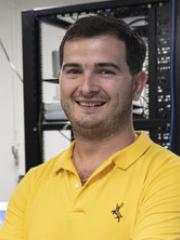Dr Mickael Mounaix

Researcher biography
PhD project fully funded available now!
My main research area is the control of the spatial and spectral/temporal properties of light, particularly through complex disordered photonics materials such as multimode optical fibers, white paint, fog or biological tissues. The scattering of light through these materials inhibits many applications such as biomedical imaging and optical telecommunications, as it prevents light from being delivered to the desired position(s) at the desired time(s).
To achieve such level of control, I'm using a spatial light modulator in addition to some lab-made software techniques.
Recent research achievements:
- Time reversed optical waves by arbitrary vector spatiotemporal field generation : Nature Communications volume 11, Article number: 5813 (2020)
This work is part of an international collaboration with Nokia Bell Laboratories, Crawford Hill Labs in Holmdel, NJ, USA with Dr Nicolas Fontaine and colleagues.
Lossless linear propagation of waves is linear in time, a principle which can be used to create time reversed waves. Such waves are "pre-scattered" spatio-temporal fields, which propagate through a complex medium (which induces scattering) and arrive after propagation as a desired target field. Time reversed waves were previously demonstrated for relatively lower frequency waves such as water waves, acoustics waves and micro waves. Many attempts have been made to extend these techniques into optics, however the much higher frequencies of optics do not able a direct measurement of the spatio-temporal optical field, flip its time response and send it backwards. A fully time reversed wave is a volumetric field (2 transverse and 1 longitudinal dimensions) with arbitrary amplitude, phase and polarization at every point in space and time. The creation of such fields has not been possible in optics.
We have demonstrated time reversed optical waves with a new device capable of independently controlling all light's classical degrees of freedom simultaneously. Such device is capable of generating a sequence of arbitrary 2D spatial/polarisation wavefronts at a bandwidth-limited rate (4.4 THz). This new ability to manipulate the full field of an optical beam could be used to control both linear and nonlinear optical phenomena.
Youtube video article: 5 min abstract link which explains the motivation, the setup and some applications. A 75 minutes full technical presentation link presents in depth the results with pedagocial graphics.
The paper was published in "Time reversed optical waves by arbitrary vector spatiotemporal field generation", Nature Communications volume 11, Article number: 5813 (2020) link
Press Release: Physicists create time reversed optical waves, by the UQ News media team link, reposted by different science websites including Phys.org
Conference presentation: I have presented these results at the CLEO virtual conference 2020, the video is accessible for free after registration on the CLEO page (paper SM2H.7) link
- Control of the temporal and polarization response of a multimode fibre: Nature Communications volume 10, Article number: 5085 (2019)
With Dr Joel Carpenter, we have demonstrated how to control light delivery after propagation through a multimode fibre in the temporal domain. Because of the natural mode coupling within a multimode fibre, the impulse response of light gets temporally stretched, over multiple order of magnitudes (picoseconds to nanoseconds) compared to the initial pulse duration (usually ~100 femtoseconds). We notably demonstrated in this work how to maximize the impulse response at arbitrary delay(s), and how to minimize the impulse response, with polarization-resolution.
The results were published in "Control of the temporal and polarization response of a multimode fiber" Nature Communications 10 5085 (2019) link
Press Release: Cutting through fog with laser focus, by the UQ News media team link, reposted by different science websites including Phys.org
Conference presentation: I have presented these results at the CLEO virtual conference 2020, the video is accessible for free after registration on the CLEO page (paper SM1L.3) link
